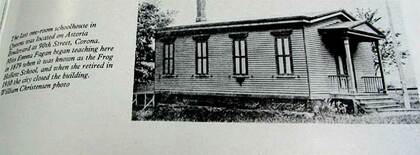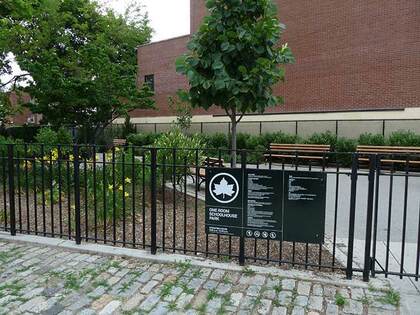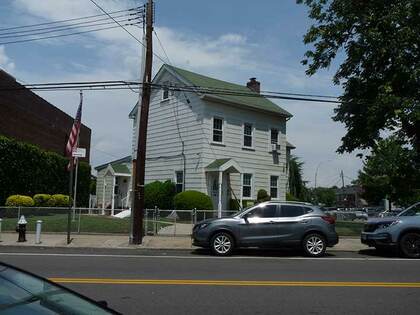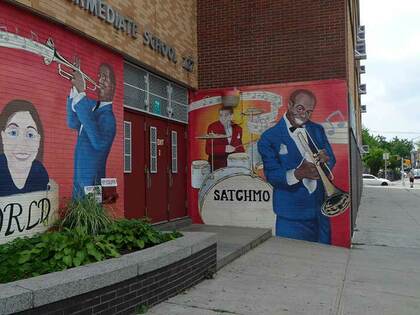Jackson Heights isn’t named for President Andrew Jackson. It’s named for the man who built Northern Blvd. in 1859, opened to traffic in 1860, between what is now Vernon Blvd. and the Flushing River by the Hunter’s Point, Newtown and Flushing Turnpike Company. It connected to roads further east past the Flushing River, but the newly-built stretch was named Jackson Ave. for the turnpike company’s construction supervisor, John C. Jackson. By 1920, most of the road was renamed Northern Blvd., with the westernmost section between Vernon Blvd. and Queens Plaza retaining the old name. There’s an existing original Jackson Avenue milestone at the Queens Historical Society in Flushing.
I took a walk through Jackson Heights in the summer of 2022, and found some items of which you may be unaware. Seen above is the jewel of the north shore of Queens, the Fair Theater, a 600-seater that opened on Astoria Blvd. and 90th St. on December 25, 1937 with a double feature: Dead End with Humphrey Bogart and a Bing Crosby musical, Double or Nothing. It was never part of a chain and showed movies past their expiration date at a cut-rate price. It was named in anticipation of the 1939 World’s Fair opening a mile or so away.
Over the years the Fair evolved into a grindhouse and a porno palace servicing the raincoat brigade, but in recent years it has played up some new fare: Indian and Asian action/kung fu flicks. There will always be a shady aspect to the place, and a New York Post article in 2007 reported that it still was showing porno flicks, but that was years ago. There was a lawsuit in the past from an adjoining storefront church.


One Room Schoolhouse Park, Astoria Blvd. and 90th St., sits on a .14 acre plot that was home to the schoolhouse mentioned in the park’s name, PS 10, from 1879 to its demolition in 1934. Before receiving the designation PS 10 it was known as Frog Hollow School, and remained a school through 1910 (by some accounts, 1925).
Before the construction of massive apartments by the Queensboro Corporation and its remaining Jackson Heights in the early-20th century, the neighborhood was a swampy meadow home to occasional homes and traversed by only a few roads: Flushing Ave., now Astoria Blvd.; a toll road built in the 1850s by John Jackson and named Jackson Ave. before becoming Northern Blvd. around 1920; and by Trains Meadows Rd., a diagonal country road of which there are few remnants today.
After the school’s demolition in 1934 NYC Parks acquired the property, and turned it into a playground with swings and other entertainment for kids. A renovation decades later in the 1980s removed the playground furniture and turned it into a grassy area with benches. In 1996 NYC Councilmembers John D. Sabini and Helen M. Marshall drafted a bill naming the park for the one-room schoolhouse, and Mayor Rudy Giuliani signed it in 1996.

Mount Everest is the tallest mountain in the world at just over 29,000 feet and sits on the border of China and Nepal, the mountain George Mallory died trying to climb in 1921 and of which Sir Edmund Hillary finally achieved the summit 30 years later. It’s also 7530 miles from New York City as the crow flies. So why is the corner of 75th St. and 31st Ave. marked “Mount Everest Way,” as it has been since 2019?
The answer is the increasing numbers of Nepalese who make Queens their home. So many, in fact, that Nepalese has been added to the lists of languages translated at nearby Elmhurst Hospital, which is becoming “The World’s Hospital” just as the #7 Flushing Line is known as “The International Express.” I was sewn up at Elmhurst in 2011 after bashing my head on a guardrail after an ill-advised Metropolitan Avenue Bridge crossing.
The Sherpa are best known for their services as mountain guides and the provision of assistance to adventurers climbing Himalayan peaks. Tenzing Norgay, likely the most widely-known Sherpa in history, aided Hillary, the first European to attain the peak of Everest, the tallest mountain on the globe. The Sherpa language is unique to the region they inhabit, but can be written using the Tibetan language or Dravidian script used widely in the Indian subcontinent.
Prior to the mid-1990s, there wasn’t much Sherpa immigration to the New York City area, but a small coterie gained a foothold and established the United Sherpa Association of the USA in 1996, with just a handful of members. A few years later, a former Christian church constructed in 1947 at 41st Ave. and 75th St. was purchased for the group’s headquarters. Today, NYC’s Sherpa community numbers about 2500 people, which sounds modest, but is the largest number of Sherpa outside of Nepal.

Every so often when I’m in Jackson Heights, I go to 31st Ave. and 81st St. to see how the Crooked House of Jackson Heights is doing. It’s a tidy, well-kept private dwelling on the northeast corner of the somewhat busy intersection. I’ve no idea who owns it. Instead of facing either 31st Ave. or 81st St., it instead is positioned in a diagonal fashion toward the corner. Not a lot of private homes are positioned like this, and that’s why I call it the Crooked House of Jackson Heights. (When I was in college and laying out the school paper, I was just getting used to using a T square and Gary, a fellow editor, called me “The Crooked Man” as I had trouble getting everything straight. These days, there are no Crooked Men since layouts are done with computer software. And my alma mater doesn’t even have a paper anymore.)
The unique positioning gives the house a substantial front lawn facing the corner. Usually, when a house is unusually positioned there’s a story behind it and in this case that’s no exception. What’s now Jackson Heights remained undeveloped well into the 20th century and presented a wide expanse of sparsely-populated meadows between the towns of Long Island City and Flushing. That changed in the late-1910s and into the 1920s when the Queensboro Corporation built the grand apartment buildings Jackson Heights is known for today. The street grid was then filled in and houses arrived and by WWII, Jackson Heights was fully built out.
In the early-20th century, only a few roads and a couple of trolley lines crossed what was then called Trains Meadow (the derivation is unclear). One was Trains Meadow Rd., which cut northeast from Woodside. The road itself was laid out as early as the 1670s and ran from Woodside to Flushing Bay originally, but as the overall grid was built the road ceased to be important and fell into disuse. Of the homes built along Trains Meadow Rd., few survive, one the house at 31st Ave. and 81st St., which once had a Trains Meadow Road address but is now plain 80-19 31st Ave.

Junction Blvd. and 94th St. could be considered the west edge of Corona, so it’s appropriate that Intermediate School 227 has been named the Louis Armstrong School for Satchmo, one of jazz/pop’s greatest trumpeters and goodwill agent for six decades. Tim Payne’s murals here were first painted in 2009; Armstrong was a Corona resident from 1943 until his death in 1971, and his home has since been converted into a popular museum honoring his life and work.
—Kevin Walsh is the webmaster of the award-winning website Forgotten NY, and the author of the books Forgotten New York (HarperCollins, 2006) and also, with the Greater Astoria Historical Society, Forgotten Queens (Arcadia, 2013)

